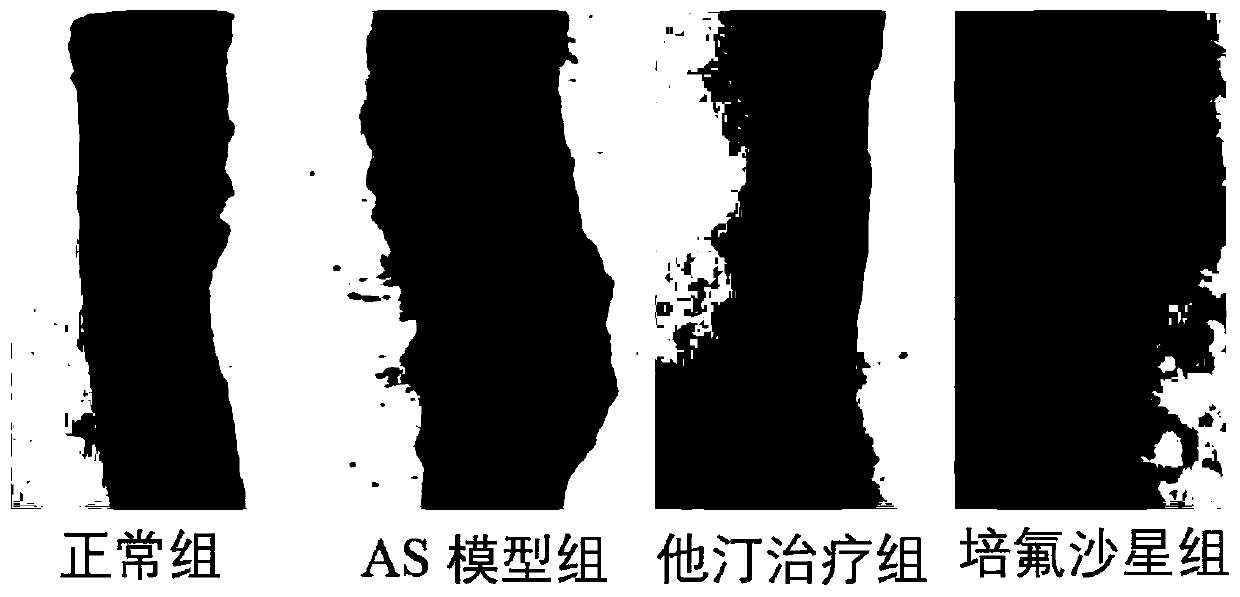Use of pefloxacin in preparation of drugs for treatment and prevention of hyperlipidemia or atherosclerosis
A technology for atherosclerosis and pefloxacin, which is applied in the field of preparation of drugs for treating and preventing hyperlipidemia or atherosclerosis, and pefloxacin, can solve the problems of poor clostridium effect and the like, and achieve safety High, strong pharmacological effects, wide-ranging effects
- Summary
- Abstract
- Description
- Claims
- Application Information
AI Technical Summary
Problems solved by technology
Method used
Image
Examples
Embodiment 1
[0021] Example 1: Rats fed with high-fat feed form a lipid metabolism disorder model
[0022] Forty male SD rats, weighing 160-180g, were fed adaptively for 5 days. The animals were stratified by body weight and then randomly divided into 4 groups with 10 rats in each group. The high-fat feed formula is as follows: lard 10%, cholesterol 2%, propylthiouracil 0.2%, pig bile salt 0.5%, and basic feed 87.3%. Animals were fed high-fat feed for modeling (except for the normal group) and given pefloxacin for 19 consecutive days. On the 20th day, the rats were anesthetized with 25% urethane (0.4ml / 100g), blood was collected from the abdominal aorta, and the serum was centrifuged to determine triglycerides (TG), cholesterol (CHO), and high-density lipoprotein (HDL-C). ), low-density lipoprotein (LDL-C), the results are shown in Table 1 and Table 2. From Table 1, it can be seen that pefloxacin can significantly reduce the content of triglycerides and cholesterol in the serum of high-fat r...
Embodiment 2
[0029] Example 2: Obesity model formed by feeding Kunming mice with high fat feed
[0030] Forty 6-week-old male Kunming mice (18-22g) were kept in a dry, clean and well-ventilated environment at a temperature of (24±1)℃. The mice were randomly divided into 4 groups, each with 10 mice. The mice in each group were raised in separate cages, and there was no significant difference in body weight. The blank control group was fed basic feed, and the other groups were fed high-fat feed. After 1 week of pre-feeding, the blank group: fed basic feed and gavage normal saline; positive control group: fed high-fat feed and gavage atorvastatin 10mg / (kg BW·d); high-fat model group: fed Feed high-fat feed and gavage normal saline; Pefloxacin group: feed high-fat feed and gavage 50mg / (kg BW·d) Pefloxacin drug solution. During the experiment, the mice in each group drink and eat freely, and are weighed every weekend. Continue feeding and gavage for 30 days. It can be seen from Table 3 that af...
Embodiment 3
[0034] Example 3: New Zealand white rabbits fed high-fat diet to form atherosclerosis model
[0035] Forty male New Zealand white rabbits weighing 2 kg were fed adaptively for 7 days. The animals were stratified by body weight and then randomly divided into 4 groups using a random number table, each with 10 rabbits. Animals were fed high-fat diets (except for the normal group) and were given pefloxacin or the positive drug atorvastatin for 2 consecutive months. After the experiment, blood was collected from the ear vein, and the serum was centrifuged to determine TG and CHO; the experimental results are shown in Table 3. From Table 3, it can be seen that pefloxacin can significantly reduce TG and CHO in the serum of high-fat white rabbits. The effect of floxacin in reducing triglycerides was significantly better than that of the atorvastatin group; the aorta and liver were separated, and oil red staining and HE staining were performed respectively. The effects of each group on th...
PUM
 Login to View More
Login to View More Abstract
Description
Claims
Application Information
 Login to View More
Login to View More - R&D
- Intellectual Property
- Life Sciences
- Materials
- Tech Scout
- Unparalleled Data Quality
- Higher Quality Content
- 60% Fewer Hallucinations
Browse by: Latest US Patents, China's latest patents, Technical Efficacy Thesaurus, Application Domain, Technology Topic, Popular Technical Reports.
© 2025 PatSnap. All rights reserved.Legal|Privacy policy|Modern Slavery Act Transparency Statement|Sitemap|About US| Contact US: help@patsnap.com



